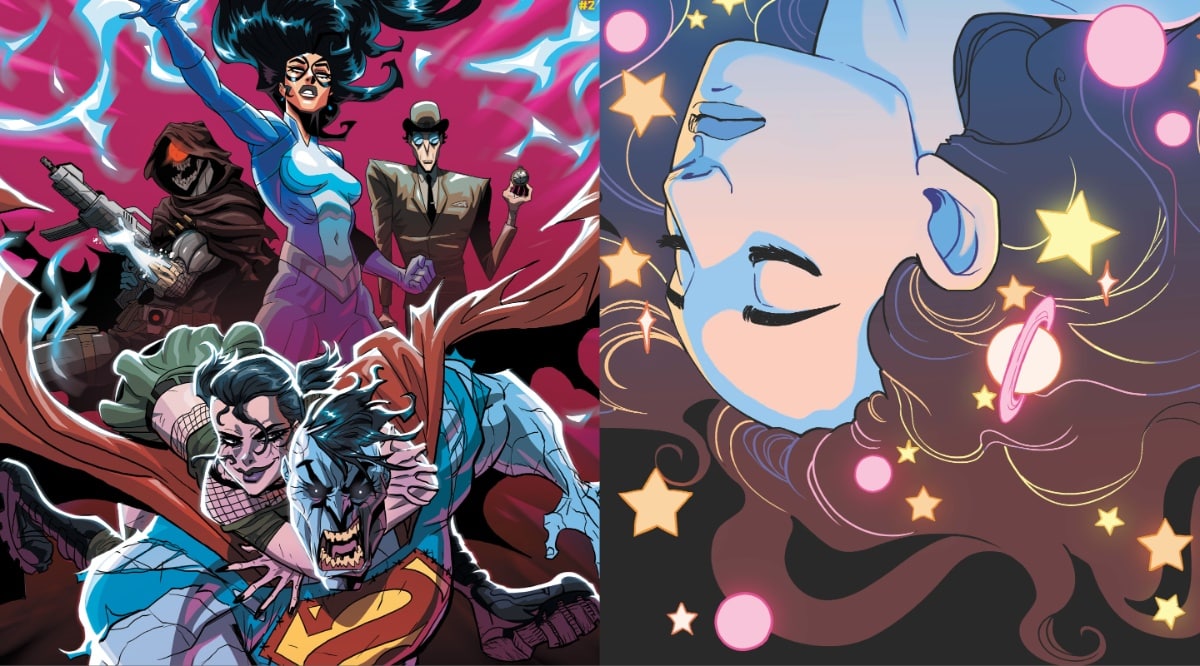Every Wednesday, I sit down with Brandon Montclare, writer of the hit Image series Rocket Girl and co-writer of Marvel’s upcoming Moon Girl and Devil Dinosaur series. We gab about what we’re reading now, what books we consider classics (Brandon loves Dark Knight Strikes Again…), and the hottest gossip of the industry. Oh, and sometimes the inimitable artist Amy Reeder (Rocket Girl, Batwoman) stops by. Check out our full show archive at podcornpodcast.com.
With the closing of co-host Brandon Montclare’s old store, Alternate Realities, and Brooklyn boutique store Bergen Street Comics, we ask the question: what is the future of comics retail?
Are stores dying out?
Are the retailer incentive variants killing them?
What’s the real reason why comics haven’t changed when all the entertainment industries surrounding them have?
Answers to those questions and more this week…
Intro/Outro music this week is The Shade by Metric, from their new album Pagans in Vegas.
Visit rocketgirl.nyc for swag from Brandon and Amy!
Subscribe on iTunes so you never miss a…beat.









The podcast appears to be an hour and a half long. Any chance we could read the highlights somewhere?
That is what treadmills are for. Get fit with podcasts!
If you’re going to talk about the current comics market, I think you might want to actually talk to someone who currently sells comics in some capacity instead of making wild speculative guesses about what the individual businesses’ model and reasoning and viability might possibly be?
You guys got it maybe 25% right, but the other three quarters was really kind of massively misinformed in so so so many ways about how the math works for who and how and when :(
From the little I know, you have it entirely wrong about Bergen St.’s profitability and motivation, in an entirely insulting way.
-B
“how do you get people to buy #4?”
Have #1-3 be transcendent wonderful of-the-moment comics.
But, really, for non-name non-exciting product the game is actually to get to the third TP collection (5-800 pages of material) — once you hit 6 inches of spine-out rack space then, maybe, you get enough shelf presence to move work to the next level.
-B
It’s rare to have a transcendent #1-3… but it happens more often than a #4 increase in sales, I’m sure you’ll agree. Which is why the question needs asking, I think.
As for the other stuff… yeah, you’re probably right. But it’s a casual conversation, not an essay. I thought we (or I) embraced it for the rant it was. I’m not looking to be dispositive. You should have stuck your fingers in your ears like I said! For what it’s worth: I owned a store for a long time–and throughtout and for almost 10 years after I left, it was very successful. One of Diamond’s Top 100 accounts by dollars. And that was all comics, as we were direct with most card, games, T-shirts, and statue companies. In the 10 years I’ve worked in publishing, I’m sure a lot has changed. But it doesn’t LOOK like a lot has changed. That being said: I know as much as anyone that you can’t get a real picture from the outside looking in. So YMMV.
There is always always always always always a drop in consumer sales in a series from #1 to #whatever — whether that is comical books or Netflix views — so for a comics series to GROW in sales with issue #4, the *only* way that can happen is that the first three issues were *under*-ordered. Which is exactly why it happens in the rare occasions that it does.
-B
We all know #1 will sell the most copies. But what about when a major publisher forwards a creator an chart that says a 69-74% drop by #4 is considered normal–the “standard” in standard attrition… with more drops each following number? I think there’s a whole lot of room to improve between the impossible 101% and the accepted-as-normal 26%.
You can blame the content–but I think that’s likely unfair in a world where comics content is ubiquitous and in-demand across all media.
And while a significant minority, it is not a rare thing that books–especially early numbers–are under ordered:
1) Anecdotally, I’ve seen many books where #2 and/or #3 are cut too much. Reorders go quick and then those numbers are gone. Not just from Diamond, but off the shelf. And I think a lot of retailers are hesitant to up #4’s significantly above their total sales on #3–that’s a tough mentality to crack because they don’t know if the customers who lost out on #3 will instead opt to wait-for-the-trade.
1a) If Saga-like comics get their numbers bumped at 6, 11, 16, 21 (ie: singles after a trade)–that’s evidence singles were under ordered.
2) With all due respect to all retailers, I think it’s safe to say that some retailers cut orders on #2-4 more based on habit that close scrutiney of actual sales.
3) I’ve done it. I’ve hand-fed multiple, major stores sold out issues from my personal stock. Telling them I’ll take them back if unsold. When I did that with 1s, 2s, & 3s, orders for 4s, 5s, 6s increased. And it’s continued growth as I restock #4s, 5s &c when Diamond is out of those. I see the inititial orders, I see FOC, and I get the calls for restock. It’s hundreds of copies per issue–a little more than 5% of total Rocket Girl sales are by me, after Diamond sells out.
4) #1’s sell the most… with 100% of the marketing budget. It makes sense, but maybe a small but significant part of that is self-fulfilling-prophecy. When did anyone ever push a #4? And you don’t even have to make #4 a discrete marketing project–how about pushing “the series” three months after a launch–never happens, not even if the book is “transcendent.”
Now, maybe paragraphs 1-4 above don’t add up to a revolution. But maybe they do make a favorable dent of a few points in that “standard attrition” (which a cynic would say is code for “not my fault”) of the 75% drop some say you shouldn’t try to stop by #5. I call bullshit and we can do better. And, again, those are just small ideas that came to my head in an unscripted, unplanned podcast chat. Where’s our #4 Manhattan Project (the thinktank, not the Image book)?
Check this article about Netflix: http://www.slate.com/blogs/browbeat/2015/09/24/netflix_knows_what_episodes_of_our_favorite_tv_shows_got_us_hooked.html
“Netflix analyzed data for 25 shows, and found the episode within each series after which 70 percent of people continued watching for the rest of its first season.”
So a 1/3 *OR GREATER* drop is *absolutely normal* in serialized fiction in general
If you read that article, ARROW’s transitional episode came at #8, so, at best, .7 of .7 of .7 of .7 of .7 of .7 of .7, which, if I did the math right (I Might not have done so!!!) says that like only 6% of the audience for episode #1 made it to #8?
People like to sample a whole lot of stuff, but those who FOLLOW it, is a substantially lower number. Trying to deny that is, basically, nuts, and I suspect that, overall, comics keep a higher percentage, over all, at #4 of a serialization from another media because we have an actual culture around buying comics on a particular day!
[My personal rule of thumb in ordering is 80% of #1 for #2, and 80% of that for #3, for whatever that is worth — 10, 8, 6 — but here’s the FUNDAMENTAL place that your 10-years-out-of-date ordering experience lets you down — WE HAVE FOC TODAY, and we can make radical changes in orders 3 weeks out from publication]
Now, is it true that some retailers miss maximizing sales on some titles because of the non-returnable nature of comics, and the conserrvatism that engenders?? Oh yes, of course — but I firmly believe that the overwhelming majority of full-service retailers are looking to maximize the number of copies they sell of every comic that they carry. Why? Because if they don’t do so THEY GO OUT OF BUSINESS.
The actual math of the DM says that if you don’t order mostly right, most of the time, you go out of business.
The market isn’t supposed to look like you or I or a neutral third party might *want* it to be — it’s supposed to look like it *is*, and the cold fact is that the overwhelming majority of titles are bought at the “right” level, in that there are still plenty of copies on the market to purchase, and that demand for later issues isn’t scaling up for the market as a whole — for every anecdote you can show about providing 5% in restock, I suspect I can find you five stores that have 20% leftover in overstock.
But if you truly and sincerely believe that #2 and #3 are *Systematically* under-ordered, then the solution seems simple (short term) — double or triple ship those #2s and #3s, believing that the market will correct orders at #4 and #5.
In fact, maximizing early orders seems to be the trick to get the market to perform better than its native conservatism would seem to suggest, but when you see a recurring pattern over and over and over again, perhaps, just maybe, orders reflect a pattern that reflects our ordering experience? We DO lost half the audience between #1 and #2…. except when we don’t. But if I had to place a bet on any random title, I’d absolutely place it as a big loss between issues because that’s how most books are for most issues.
There are, OF COURSE, exceptions to that pattern, but they’re generally fairly rare because inefficient markets almost always collapse, and the DM is so very far from collapse at the moment…..
-B
I don’t want to take the bait about having not worked in retail for 10 years and turn this into a quarrel, but: I’ve scriutinized exact Initial vs FOC numbers for every store in the world on a significant number of books over the years from Image, DC, Vertigo; here and there with Marvel books; pay attention when these subjects come up with publishers; and have had scores of conversations with retailers on FOC day about FOC.
And we’re not even saying very different things. What I’m saying is that there is value in addressing your specific above concessions with publisher tools: publicity, information, returnability, other incentive/sales support, etc (and it doesn’t even have to be limited to publisher interaction). I think addressing ‘standard attrition’ post-#1 is something that makes a difference. I’ve still never said it’s going to raise number 4 above #1–but I think there is room for improvement.
And some specific responses: I think, unfortunately, the human component of 10-8-6 (I stress: only for some retailers) sometimes supersedes FOC analysis based actual sales. I think conservatism that hurts the busiess can be ameliorated by the tools in the previous paragraph. I recognize (and this was the point most discussed in the podcast) that OVERordering is probably a contributing factor for most stores that go out-of-business. But that doesn’t mean UNDERordering isn’t also an issue that effects the chain of creator-publisher-distributor-retailer-fan. And for the record: despite the podcast’s provocative title (which I didn’t choose!) the audio goes at great length to say the DM is not only viable, but recognized by publishers as the supreme channel.
The Netflix stuff is very interesting… but still very far from the DM. The huge difference being everything being on-demand at once. There are people today sampling the first episode of Walking Dead or Breaking Bad today because their friends have been talking about it for years. And it’s free (assuming you have the service anyway). So of course the drop off should be higher with free, home-delivered video-on-demand than you find in an informed hobby audience that is investing money-per-book.
In the DM, if you’ve heard good things about a book (and I’m again talking core customers–not civilians) and all there is is #4 on the shelf–there’s very rarely going to be a sampling. At that point, we’re in wait-for-the-trade mode–which does have con’s as well as the pro’s.
And regarding the common wisdom of maximizing a #1 launch, because the higher you start, the longer you can shed readers until you have to cancel (and relaunch)… I think it’s both very true and very dangerous. You can’t deny it, but to live by it without expanding your worldview… it’s the death of 1000 cuts. Forget #1s and #4s… when you have the .1 to 1 to 2 to 3% standard attrition on books that have been around for years, you have a fundemental business problem. That’s how you go from 108,000 copies of 2005 non-#1 Green Lantern to 42,000 copies of 2015 non-#1 Green Lantern. At the end of the day: I’m saying there’s an opportunity in those 64,000 lost copies–but some publishers and retailers instead throw their hands up and say “That’s Life!” I don’t know if I have any of the answers–but I’m not so cynical to believe it’s not worth talking about.
Regarding the Rocket Girl anecdote for #2 & #3. I can be conservative and say I put 500 copies of each into a handful stores (this is AFTER overprints sold out from Diamond). I don’t think the math of your counterargument holds up, because it’s +5% of the entire DM–not +5% of those individula stores. I’d have to dig up the numbers, but stores (and to be fair, it was only is stores were RG sales were already strong) where I supplied extras had increases of ~50-300% over orders shipped + reorders. The restocked copies were not dumped all at once, but over multiple shipments as needed.
And I don’t think you will find a lot of stores with extra copies because RG 2 & 3 were returnable–and returns were so close to zero I don’t even remember them. (And if any retailer has extra 2s & 3s–I need them!). But overships and returnability are only part of the equation–so much more could be done.
Now, does my biased POV on Rocket Girl dispositively evidence a systemic problem? Of course not. But, again, I do think we as a business are missing opportunities to better sustain ongoing series sales (while undervaluing the importance of sustaining ongoing series).
Nobody understands better than me that a market is what it is. But we’re all actors! It is what we’ve made it. The market doesn’t exist outside of us!? We don’t respond to a market… we create it. We’re the manufacturers and distributors and consumers. Our actions have consequences that define the market.
We’re nearing the end of the page, so this will scroll off soon, then I’ll never check it!
Let me be clear that any “10 years gone” is not about trying to turn this into a fight — but rather that the market has truly changed in that time span: beside FOC, there’s a significantly higher number of titles being published, significantly more viable publishers, etc — all of these things increase the native level of conservatism among ordering retailers that is *really* hard to communicate or understand if you’re not actively, actually living it. IMHO, at least. Doing an order form used to be like 4 hours a month, now some WEEKS I put in nearly four hours working it.
WRT netflix vs DM, etc — Frankly, I think “comes to your house, for free” would natively encourage more “sticking with something you don’t LOVE” than having to pay $3-4 for the same transaction. Either way, we can see the SAME pattern in numbered book series — WALKING DEAD v1 or SANDMAN v1 or PREACHER v1 sells MUCH more copies than v9 of any of those series… and I’m talking about the book channels there, not the DM. I presume (though don’t have access to hard data) that the same is true for numbered prose book series, and I’m fairly certain (but too lazy to go look it up) that the same is true for broadcast TV series, etc.
Standard attrition is a real thing.
Now, OF COURSE, I will stipulate that *some* retailers are too slow or too lazy or too disconnected or too whatever to do a great job in (re) stocking their shelves — but I firmly maintain that it HAS to be a minority, simply because there’s not enough profit in comics retail for guys who consistently do a shitty job to continue to stay in business over the long haul.
I think it is too easy to blame the market when things don’t get success the way that you (or I!) feel that they should; and I think you overstate the ability of an individual actor to (consistently, at least) impact the overall market: customers don’t care about we want, they care about what they want. When you CAN change them, it’s almost always with an enormous investment of time and energy — I say again: the market generally doesn’t start recognizing creative success until you’re about 3 books (or 4-500 pages) in and you build enough “rack presence” to show that you’re actually In the game.
-B
It’s probably correct that you are 100% and I am 100% wrong… certainly all the publishing apparatus agrees with you: standard attrition is “standard;” the only way to bear it is relaunches. Still, I dont buy it! Moreover, I think relaunches have a diminishing return: as evidenced by numbers of common books like Green Lantern today vs 2005.
If your store has staff-favorite titles that outperform their relative Diamond Top 300 rank, you’re bucking the system and evidencing opportunities that defy the concept of an unchangeable market.
If your Saga to Batman ratio is better than 39:100, you’re bucking the system.
If you’re ordering based on sell through and not to hit variant incentives—despite publisher’s exhaustive promotion efforts on variants—you’re bucking the system.
En masse, FOC adjustments are as predictable as standard attrition—so if you’re a retailer that uses FOC effectively and that causes different variation to different titles, month-in-month-out, you’re bucking the system.
All of these are small things, but I think can add up to something significant. They are also, in my inexpert opinion, qualities of healthy stores.
http://www.savagecritic.com/retailing/comix-experience-best-sellers-2014-comics/
Change that last word to “books” for the other chart and the overview (two or more links get you marked as spam here) — only 3 months until this year’s report :)
So, by each and every metric you mention, Brandon, we at Comix Experience are bucking the system…. and yet “standard attrition” STILL applies to 85%+ of all new books, uniformly and across the board — hell we’re pretty much at 10 8 6 for Saga #1-3 (and 7-9, and 13-15, and 19-21, and 25-27!) even with new “jumping on points” — people sample, people graze, people leave, it’s simply how the game is played.
And it really is OK.
It took me *26* years to get CE into a place where we can post those kinds of numbers, and, still, 20% of the people who bought SAGA #1 didn’t come back for #2. That’s not an indictment of the system — it’s just the way stuff works.
The reason that GL is now selling as badly as it does today compared to the relaunch is that 1) “Star author” Geoff Johns is no longer involved, and DC has not put A-selling talent on the book since his absence 2) There are far too many GL-related books…. even today, and 3) making “space cop with a magic wishing ring” a “renegade” is a pants storyline that no one wants — it isn’t something INTRINSIC to the market (or failures there of) — it is INTRINSIC TO THE *W*O*R*K*
You can ABSOLUTELY take a failing book, and give it a goose without “relaunching” — exhibit A in 2015 might be BATGIRL — put good talent with a clear and solid take and don’t give them editorial interference and more copies can be sold. SAGA isn’t a series of 6-issue minis (though they could have done that), and we got solid healthy spikes at 7, 13, 19 and 25…
I really think that looking at the way that Marvel and DC are *mismanaging* their libraries should not be the analysis on the health or not of the medium of comics… just of those two individual brands of comics. Comics aren’t Marvel, comics aren’t DC.
-B
I don’t understand how you assert that Standard Attrition is both a universal constant AND quality is something that can affect Standard Attrition? That seems contradictory.
And Comix Experience beating, at least in part, standard attrition on 15% of books when the industry does it only 1% of the time is exactly what I’m talking about! If the whole business mirrored your average, it would be a huge shift and indicative that things CAN change. And if Green Lantern is an extreme example, the DCU average is down 30% over 10 years. And in those 10 years, comics penetration into mass culture has grown astronomically.
Otherwise what’s the thesis? Put aside big numbers on first issues. The ~1% loss any book might lose between #26 and #27 (or whatever)… that 1% drop happens when publishers do ZERO about it. I can’t accept that if they put SOME effort in they couldn’t combat that accepted-as-inevitable drop? And then you wouldn’t have the 1000 cuts that take average sales per title from 46,500 to 33,000 over 10 years.
Things are what they are…. unless they’re not. “The exception that proves the rule” or whatever.
You misunderstand “15%” — it isn’t that we’re beating Attrition on 15%, it’s that 15% *hold the potential* to beat it. (and, honestly? I’m probably being extremely Pollyanna about that kind of percentage….)
The DCU average is down 30% over the last ten years because 1) they’ve actively and aggressively chased away most of their “traditional” audience, and that 2) most of their comics kind of suck, and 3) they’re radically overproducing their icon characters in ways that only the hardest of the hardcore can continue on.
It would be terrific if just trying to reverse attrition worked effortlessly… but it’s a massive massive effort and there’s only an extremely limited amount of bandwidth — if it takes you the same amount of promotional effort to reverse attrition for #27 as it does to launch your new #1 (and I submit that it pretty much does), then where is the better place to spend extremely limited manpower and capital?
Again: things sell the way they do not from maliciousness or from neglect, but because that’s what the market actually wants (and / or doesn’t) when you’re dealing with established titles.
But we’re talking in circles now, and we’re about to scroll off the front page, so I’ll leave the last word to you, if you choose to take it….
-B
Thanks for giving me the last word. I’ll try to keep it brief (but will probably fail)!
1) I don’t attribute maliciousness on the part of anyone. Neglect, perhaps a little, insofar as I think human nature sometimes settles into the easiest habits. But I think it’s all a case of positive potential.
2) I don’t think it’s all or nothing (nor of equal importance). I don’t think it’s MORE important to promote #4/#27 over #1 (nor equal). I just think it is important and there’s untapped potential; moreover, there is unnoticed harm being done month over month and year over year.
2a) I disagree that it takes equal effort to promote either. And what I do know is that no sustained, focused effort has ever been applied to ongoing series promotion. It’s Launch, Launch, Launch, with a dab of variant covers. The closest we come is tying singles to TPB sales.
What’s unsaid in this thread is how sustaining monthly sales is ESSENTIAL to creator-owned books, who don’t have the stability of a ‘line’ that has peaks and valleys across multiple titles. And regardless of personal politics or preference, the business has moved a lot of top talent/top quality books into creator-owned. If the Promised Land is 450 collected pages… that’s not a lock at M/DC these days when books have no legs; it’s harder for Image, and quite unlikely at all the publishers below.
Comments are closed.